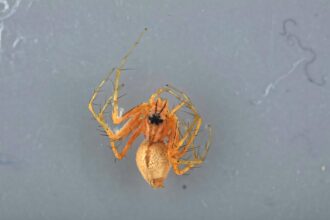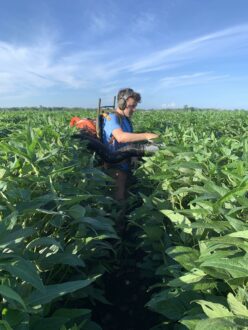BATON ROUGE, Louisiana – Conservation plantings, through various stewardship programs, do well to provide a myriad of benefits. These range from controlling erosion, to improving water quality, to promoting healthy soils. However, the impacts of such strategies on cash crop pests and the natural enemies that target them is less known.
Louisiana State University researchers, based on the observations of soybean farmers, have engaged in a two-year Southern Sustainable Agriculture Research and Education (SSARE) Graduate Student Grant project to identify arthropod natural enemies and pests within conservation plantings and determine if they move into the cash crop during the growing season.
“Farmers have told us that they see pests along the edges of conservation plantings and want to know of those pests move into their cash crop. At the same time, we also want to find out what natural enemies may be present,” said LSU entomologist Jeffrey Davis. “With farmers pulling their conservation fields out of production and putting them into corn to take advantage of the high corn prices, it’s important that we show value in conservation strategies, not only from an environmental standpoint, but also from the biological control standpoint.”
Davis, along with graduate student Scott Lee, partnered with soybean farmers in northern Louisiana to plant hedgerow conservation strips of cover crops alongside soybean fields. They used such crops as hairy vetch, switchgrass, turkeyfoot, and berseem and crimson clovers – common cover crops for the area. They then identified and tracked pests potentially migrating into the cash crop, as well as the natural enemies that might be following them. The researchers focused on certain points of the soybean growing season, such as initial flowering and pod development.
Lee said they collected both pests and natural enemies during the project. They tracked which insects were moving from the conservation plantings into the soybean crop using egg whites.
“We sprayed a solution of egg whites along a transect area within the conservation planting, and were able to identify the insects that moved from the conservation plantings into the soybeans by confirming the presence of an egg protein marker on the insects,” said Lee.

A year into the project, the researchers identified such pests as stink bugs, mainly the southern green stink bug and the red-banded stink bug. Additionally, they identified a number of generalist predators, such as lynx spiders, wolf spiders, crab spiders, assassin bugs and big-eyed bugs. Davis and Lee found red-banded stink bugs congregating on crimson clover then moving to the soybean fields.
“Crimson clover is Red Bull for red-banded stink bugs,” said Davis. The good news was that the researchers also found predators, mainly spiders, in large numbers in the soybean fields. “So, the spiders appear to be following the pests. They are the major predators in the soybean fields,” said Davis.
Although still in the preliminary stages, the project points to the importance of picking the right cover crops for the area that support beneficials and keep pests in check.
“A strategy would be to tweak the cover crops mix for conservation plantings,” said Lee. “Maybe move away from the clovers and focus more on grasses and forbes. That could be one possible future study.”
The goal, the researchers emphasized, is to help farmers develop more sustainable management strategies through the right conservation planting mixes that support stable natural enemies and better control insect pests.
The project is anticipated to be completed summer of 2023.
